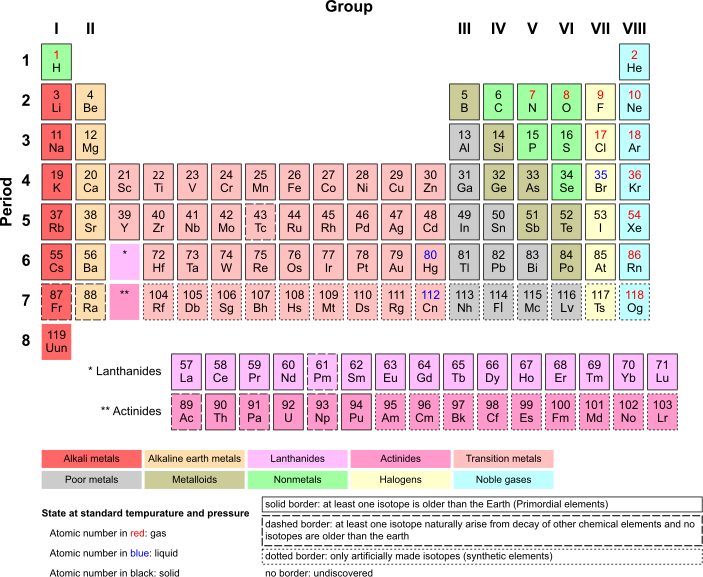
Source: Wikimedia Commons
The periodic table of the elements organizes all the chemical elements. Elements are, in most ways, the fundamental building blocks of the kind of matter that we are most familiar with. You can go smaller than an element and find protons, neutrons, electrons and quarks (and possibly go smaller/more fundamental and find strings). You can go bigger as well and find molecules built of several elements. Most of the matter we interact with is made up of molecules containing multiple elements. But in order to have water or wood or a zebra you need atoms of various chemical elements.
While most of the stuff around us on Earth is made of compounds, often quite complex compounds when it comes to what makes up living things, we do have some experience with stuff made from single elements. This is known as a "natural state." Graphite, the stuff we use to make pencils write, is pure carbon arranged in layers that can easily slip off the tip of the pencil and onto the paper. Diamond is actually one giant carbon molecule. Oxygen, while we have a less tangible relationship with it, is perhaps the most important substance to us for, y'know, not dying.
We also have experience with some metals as single element substances. Aluminum is used to make foil and cans, silver has been used to make well...silverware and other household items, gold is used in jewelry and wires. While these metals are often found naturally occurring in a larger compounds we have figured out how to use chemistry to remove the atoms of just the metal. Natural state metals are extremely useful because they tend to be extremely malleable (you can mash them into a shape, like clay...though, this may require some pretty extreme heat) and conductive (these properties are why gold is so useful for wires).
Though it may be a bit indirect, we also may have some experience with neon in the form of neon lights or signs. We use several other gases that are chemically similar to neon to make these lights. When excited with electricity, these gases will produce different colors.
But these are all experiences of substances at a gross macro level. We can talk about malleability of metals or how neon glows when excited by electricity. The factor that makes an atom a given element, though, is the number of protons. You can change the number of neutrons (and get an isotope) or the number of electrons (and get an ion) but if you change the number of protons in an atom, you change the element. Thinking about how that translates to the macro level can seem...a little strange.
Take carbon again as an example. Right next to carbon on the periodic table is nitrogen which, among other things, makes up most of Earth's atmosphere. It seems, for lack of a better word, weird, that adding a proton to the nucleus of an atom would make carbon into a gas. But that exact thing happens all the time! Well, in geologic terms. All elements have what is called a "half-life." This is the time it takes for half of a given sample to undergo a transformation into another element. Energy is required to hold even many smaller atoms together and so they do not last forever. In the case of carbon, carbon 14 (which has 6 protons and 8 neutrons) "decays" over time and becomes nitrogen 14 (7 protons and 7 neutrons).
What we more commonly think of as "radioactive" substances are substances that do this much, much more quickly. Larger atoms like thorium, plutonium and uranium also tend to decay in a way that involves particles being shot out of their nucleus. It is these particles, along with the much faster rate (carbon 14 decays in about 6,000 years, the most stable isotope of thorium in just around 18 days) that makes these isotopes dangerous. But it also means they actually turn into other elements on the scale of human lives.
The alchemists' quest to turn lead into gold may not really have succeeded, but humans have found ways using particle accelerators to ram protons into atoms so fast that they stick, changing one element into another. While experimenters have succeeded in turning other elements, like bismuth, into gold, this is only at the level of about a thousand atoms in a given trial. This is about a billionth of a billionth of a gram of gold. So while it may not be what the alchemists were looking for, it does experimentally show that what we think of at the macro level as a fairly stable, concrete thing, is changeable and just comes down to the number of protons found in the nucleus.
So what is a chemical element? Like many things in the natural world, it depends on what scale you're asking. At the macro level gold is a shiny metal substance that's really good for making things like rings and wires and such. But at the atomic level it's just the number of protons in the nucleus. If you add a proton to gold it becomes mercury and, at least at room temperature, it melts.
Sources:
http://www.preservearticles.com/201012302013/carbon-14-deca.html
https://cosmosmagazine.com/chemistry/how-noble-gases-give-us-neon-lights
http://www.bbc.co.uk/schools/gcsebitesize/science/aqa_pre_2011/rocks/metalsrev1.shtml
http://www.bbc.co.uk/schools/gcsebitesize/science/add_gateway_pre_2011/chemical/nanochemistryrev1.shtml
https://www.livescience.com/23232-smallest-ingredients-universe-physics.html
https://www.youtube.com/watch?v=7g-WOMXe6Mo
https://www.scientificamerican.com/article/fact-or-fiction-lead-can-be-turned-into-gold/